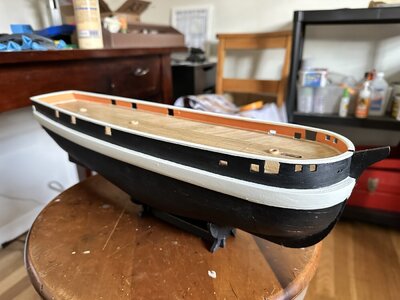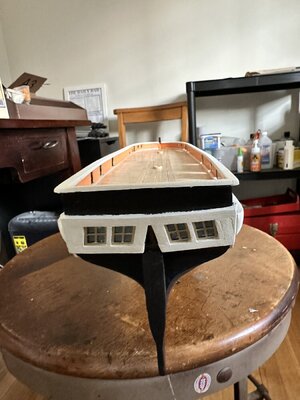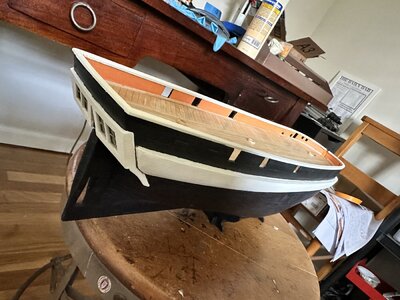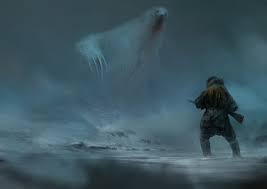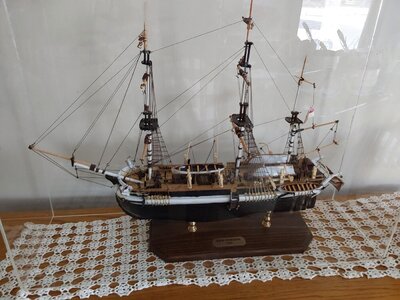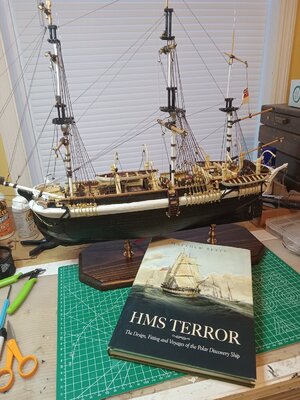You are using an out of date browser. It may not display this or other websites correctly.
You should upgrade or use an alternative browser.
You should upgrade or use an alternative browser.
also from my side a warm welcome here on board of our forum
a very good basis for a nice model - Very good work
a very good basis for a nice model - Very good work
Welcome Ben, I too am a recent member and working on my first built....also an OcCre kit - HMS Beagle. Here is my build log
Good luck and keep us posted on your progress....
Good luck and keep us posted on your progress....
Welcome to the forums ! She looks great !
Nice work Ben!
I completed my build of her this past year. It was a satisfying build, but more so because of the rich historical background associated with her and the Erebus.
Pete
I completed my build of her this past year. It was a satisfying build, but more so because of the rich historical background associated with her and the Erebus.
Pete
Thanks, yeah the history and reading about the expedition has really added to the overall build experienceNice work Ben!
I completed my build of her this past year. It was a satisfying build, but more so because of the rich historical background associated with her and the Erebus.
Pete
Read up on Matthew Betts; he's an archeologist and author on whose plans the Terror model was designed. He also wrote a book on the Franklin expedition and the history and design plan of the Terror.
The TV movie is interesting
but becomes fictionalized at the ending.
The TV movie is interesting
but becomes fictionalized at the ending.
One interesting tidbit on the Terror:
Matthew Betts noted that when the divers were down on the Terror they noted two design changes ......the davits were curved, not square; and there were two curved roof "outhouses" on each side of the stern. These were not included in the kit, I fabricated them from a piece of curved molding.
Matthew Betts noted that when the divers were down on the Terror they noted two design changes ......the davits were curved, not square; and there were two curved roof "outhouses" on each side of the stern. These were not included in the kit, I fabricated them from a piece of curved molding.
Thanks CA!
- Joined
- Jun 13, 2022
- Messages
- 238
- Points
- 143

Welcome aboard ... progressing nicely.Hello,
Ben here from New Jersey, just thought I'd post a couple of pics of the progress of my first ship build HMS Terror... this is the Occre kit and it's been a lot of fun so far. Interested to hear what people think.
View attachment 412985View attachment 412986View attachment 412987
- Joined
- Jun 17, 2021
- Messages
- 1,640
- Points
- 488

Keep up the good work!
A fun kit with history..... good instructions. looking really nice.
If you can, get the Matthew Betts book on the terror. There are some great ideas and examples there.
(My only issue was the display case. After all that work, I wanted to protect it on display.
I bought the plexiglass cut to size and assembled it myself. (first time working with plexi).
The cost here in the US exceeded $250.) Working with the solvent was challenging to say the least.
If you can, get the Matthew Betts book on the terror. There are some great ideas and examples there.
(My only issue was the display case. After all that work, I wanted to protect it on display.
I bought the plexiglass cut to size and assembled it myself. (first time working with plexi).
The cost here in the US exceeded $250.) Working with the solvent was challenging to say the least.
I'm working on the same model myself. Just working on te ice channels along the hull. Soon I'll be doing the bow plating. So I have a question that maybe someone can answer... The iron plates are referred to here and there as being "riveted" in place. Matthew Betts, in his book, shows them as having a row of rivets all the way around the perimeter of each plate in the external hull side elevation dwg on pg. 135. That would imply that they didn't overlap. But the details of the application of the actual brass plates on his model as in Figs on pp 184 and 185 show them apparently overlapped and with each plate having rivets simulated on only two edges, as they would look if overlapped and riveted in typical platework style. And they overlap from bottom to top and from aft to bow, like shingles on a roof (the upper and most forward plates being topmost.
Q: which is it? I can make an argument for both designs having advantages. Overlap seems more structurally strong as you have fewer exposed edges for the ice to get at, but on the other hand, each seam has a raised edge.
Q: which is it? I can make an argument for both designs having advantages. Overlap seems more structurally strong as you have fewer exposed edges for the ice to get at, but on the other hand, each seam has a raised edge.
I believe overlapped is correct. I think models have what appear to be plates aligned edge to edge as a simplification, making plating with pre-riveted strips of copper easier to make on a model. The best way to simulate the plating would be having each plate showing rivets along one long side and one short side, giving the appearance of properly overlapped plates.

